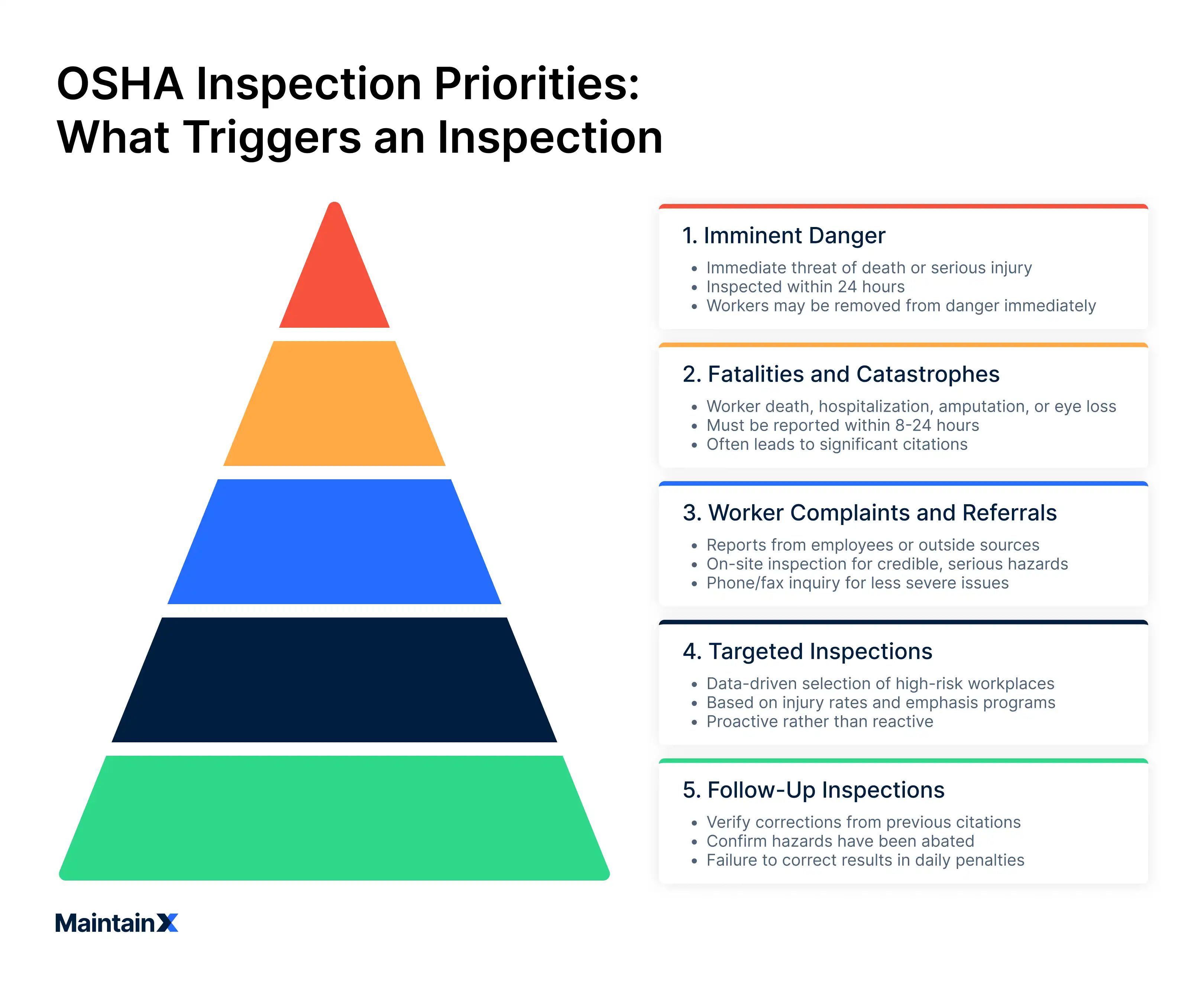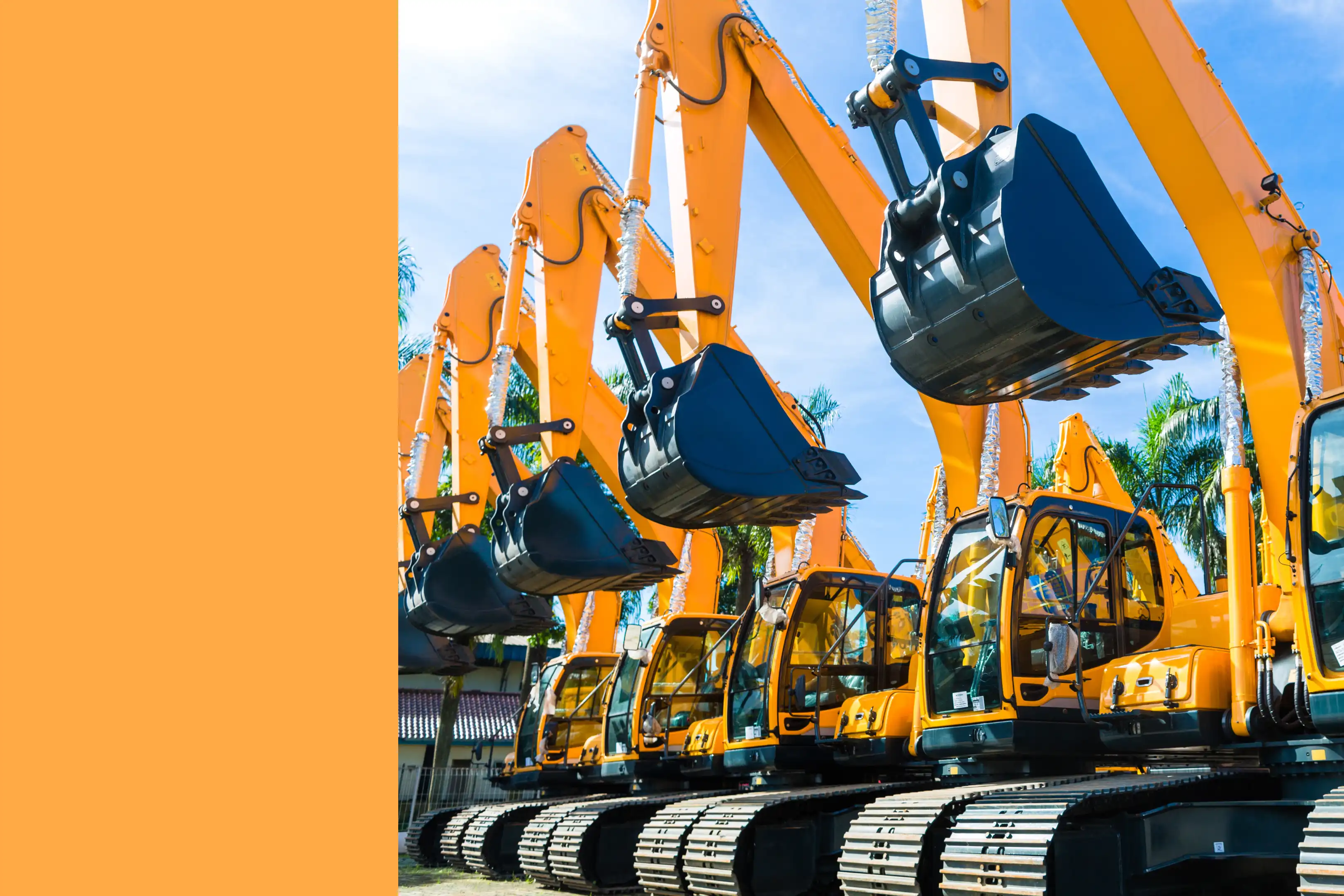
Being prepared for an OSHA inspection promotes a safety-first culture. Violations can lead to expensive penalties, and the best way to avoid these penalties is through proper preparation. Using a checklist to conduct an internal audit helps you prepare for and pass the real inspection.
In this guide, we offer a free OSHA inspection checklist that you can tweak according to your specific needs. Using a checklist, especially with a CMMS, will make the inspection process more efficient and auditable.
Key takeaways
- An OSHA inspection checklist is the most effective tool to minimize workplace injuries and prepare for an OSHA inspection.
- Keeping accurate records and conducting regular internal audits will help you avoid citations.
- Clearly define responsibilities among teams, such as maintenance crews and safety personnel, to ensure all inspection tasks are completed and documented.
- A CMMS streamlines internal inspection schedules, tracks corrective actions, centralizes documentation for both internal and external inspections, and helps automate the internal inspection process.
How to use this checklist
Our checklist covers the high-level topics and tasks that apply to most businesses. Here’s how to use it to cover your organization’s unique needs.
Understand your compliance requirements
Make sure you have an in-depth understanding of your compliance requirements before you start customizing your checklist.
Most organizations are subject to general regulations around Hazard Communication (29 CFR 1910.1200), Personal Protective Equipment (29 CFR 1910.132-138), and other basic safety standards.
Specialized facilities have additional requirements. For example, a manufacturing facility may have specific requirements for Machine Guarding (29 CFR 1910.211-219) or Process Safety Management (29 CFR 1910.119). A warehouse may be subject to requirements around Powered Industrial Trucks (29 CFR 1910.178), Walking-Working Surfaces including dockboards (29 CFR 1910.23), and more.
Customize your checklist
Once you understand the full scope of your compliance requirements, you can add and remove items from the checklist we’ve provided to reflect your circumstances.
To facilitate audits and ensure compliance, organize your documentation by site and department. The checklist should also specify which operator is responsible to perform each inspection or safety check.
Following best practices means regularly reviewing and updating your checklist to reflect changes in regulations or operations.
Use a CMMS
Import your checklist into a CMMS for easier management. It will help you:
- Track checklist progress in real time
- Add details to each work order to offer technicians context
- Interact with technicians in real time while they work on checklist tasks
- Ensure inspections are completed before each shift, to maintain compliance and safety as required by OSHA
- View auto-generated reports that help assess performance
- Prevent lost paperwork
What are the five parts of an OSHA inspection?
Understanding what happens during an OSHA operational inspection will help you prepare effectively and reduce liability for your organization.
OSHA inspections often focus on preventing accidents and investigating any accident that has occurred in the workplace. Here are five key parts of an OSHA inspection.
Presentation of credentials and opening conference
This is how the inspection formally begins. The OSHA Compliance Safety and Health Officer (CSHO) is required to show photo ID and credentials with a serial number. Make sure you or your authorized representative checks those credentials before proceeding.
Walkaround inspection
Once the inspector enters your facility, they’ll survey work areas and assess compliance. Here’s how it usually goes:
- The CSHO physically tours the workplace (or portions of it) with you, your health and safety officer, or another employee representative.
- The inspector examines your machinery, equipment, processes, work practices, and environment for hazards or violations.
- Inspectors may take photographs, take air or noise measurements, and film or take notes of unsafe conditions.
- The inspection may zero in on hazards identified in complaints or injury/illness records. If they find evidence of violations in other parts of the workplace, the scope of the inspection may expand.
- The inspector may conduct private employee interviews away from management to get candid observations.
- OSHA’s newer Worker Walkaround Rule clarifies that employees can choose a representative (an employee or, in some cases, a third party) to accompany the CSHO during the inspection, if reasonably necessary.
If you want the inspection to go smoothly, follow these best practices:
- Appoint a representative who is familiar with your operations and hazards.
- Document observations yourself (photos and notes) to compare later.
- Stay cooperative and ask clarifying questions, but avoid interfering or obstructing the process.
Employee interviews
Employee interviews help the inspector assess workplace safety by speaking to employees privately, without the presence of management.
The inspector’s goal during an interview is to gather firsthand information about work conditions and safety practices, and cross-check what’s recorded and reported (training, procedures, etc.) with what employees actually do.
Questions may cover topics such as training, safety procedures, the use of PPE, past incidents, knowledge of hazards, and the availability of safety resources.
Review of records and documentation
During or after the walkaround, the inspector will request and check relevant paperwork. Here’s what they may review:
- Injury and illness records: OSHA Form 300, 301, and 300A summaries and any supplemental logs
- Training records: Evidence that employees have been trained on hazards, safe practices, etc
- Permits, procedures, and safe work plans: Confined space entries, lockout/tagout procedures, process safety plans, etc
- Equipment inspection and maintenance logs: Repair history, calibration logs, etc., organized by department to ensure logs are easily accessible during audits
- Medical records: Where required by specific standards (respecting confidentiality and regulatory limits)
- Written safety programs or plans: Hazard communication, respiratory protection, chemical hygiene, etc.
- Certificates and variance documents
- Corrections or abatement documentation for previous violations
Closing conference
The inspection ends with a meeting where the CSHO presents management with apparent violations or hazards discovered during the inspection.
The inspector explains which OSHA standards have been violated, suggests corrective actions, and provides deadlines for fixing issues. They then explain your organization’s rights and next steps, including how to contest citations, and how to request informal conferences.
Sometimes, immediate corrections are accepted if you’re able to fix hazards on the spot. In these cases, the inspector would make a “corrected during inspection” note.
What are the five OSHA inspection priorities?
OSHA conducts workplace inspections based on various triggers, including worker complaints, referrals from other agencies, and severe injury reports. High-hazard industries may be subject to targeted inspections, too.
However, with limited resources and over 8 million workplaces under OSHA's jurisdiction, the agency cannot inspect every facility regularly. To maximize workplace safety impact, the OSHA prioritization system ranks inspection priority according to the following five factors.

Imminent danger situations
OSHA typically inspects a facility immediately upon receiving a report of an imminent danger situation, often within 24 hours.
Imminent danger situations are cases where there’s reasonable certainty that a hazard will cause death or serious physical harm immediately or before the danger can be eliminated.
Think confined-space oxygen deficiencies, exposed live electrical parts, or unstable trench walls.
During the inspection, the CSHO will verify the hazard, and may require the employer to remove workers from danger or implement temporary controls until the hazard is permanently abated. For example, if the inspector finds unguarded machinery with exposed moving parts that workers are actively operating, they’ll ask you to remove them from service immediately.
If you refuse to eliminate the hazard, OSHA may seek an injunction in federal court.
Fatalities and catastrophes
OSHA requires an inspection upon receiving a report of a worker fatality or other catastrophe.
Worker fatalities must be reported within eight hours. If one or more workers are hospitalized, lose an eye, or suffer an amputation, rules require reporting them within 24 hours.
During the inspection, the inspector will focus on identifying the cause of the incident and determining if violations contributed.
These inspections often lead to significant citations or referenced investigations (investigations at other facilities of the same employer) if criminal negligence is suspected.
Worker complaints and referrals
OSHA gives substantial weight to complaints from workers or their representatives.
They will also consider referrals from someone outside your company—a media report, union representative, state or local agencies, or other federal agencies.
If the complaint appears credible and involves serious hazards, OSHA will call for an on-site inspection.
Targeted inspections
High-risk workplaces are subject to programmed inspections. OSHA targets industries or businesses with high rates of injury or illness. Here's an overview of the selection criteria:
- National Emphasis Programs (NEPs): NEPs are OSHA-wide initiatives that focus on specific high-hazard industries or particular hazards, such as silica exposure, trenching and excavation, or fall hazards.
- Local Emphasis Programs (LEPs): LEPs are region-specific programs developed by OSHA area offices to address hazards that are prevalent in their jurisdictions, such as logging, shipbuilding, or grain-handling operations.
- Site-Specific Targeting (SST) Program: The SST program conducts inspections of establishments with high injury and illness rates based on data from OSHA's Injury Tracking Application (ITA).
Follow-up inspections
Follow-up inspections verify compliance after an initial inspection results in citations. In some cases, an employer’s appeals can also lead to a follow-up inspection.
The goal is to confirm that cited hazards have been corrected within the abatement period, and to make sure the employer hasn’t reverted to unsafe practices.
If the problem persists, OSHA may issue “failure to abate” citations, which carry daily penalties until the issue is corrected. Repeat violations discovered during follow-up inspections can result in significantly higher fines.
How to prepare for an OSHA audit
Here’s a quick guide if you’re preparing for an OSHA audit:
- Review OSHA compliance records: Make sure injury and illness logs (OSHA 300, 300A, and 301 forms) are up to date and accurate. Keep training records, inspection reports, hazard assessments, and other relevant documents accessible.
- Conduct internal audits: Walk your site as an OSHA inspector would. Use our checklist to make sure you cover all OSHA requirements during the inspection. Look for safety violations, unlabeled chemicals, missing PPE, blocked exits, engine oil leaks, or other potential hazards. Fix these violations before the actual inspection.
- Train your team: Make sure all employees understand their rights, including the right to speak privately with inspectors. Supervisors should understand the inspection process and how to respond to questions professionally and factually.
- Assign a point of contact: Assign someone to escort the inspector, manage documentation requests, take notes or photos during the inspection, and offer assistance to the inspector upon request.
- Keep documentation ready: Keep your safety policies, permits, certificates, and equipment maintenance logs organized and accessible. Quick access shows you take compliance seriously. A computerized maintenance management system (CMMS) can help you organize documents and track inspections and corrective actions.
OSHA inspections made easy
For internal inspections, a CMMS helps implement and track your OSHA inspection checklist.
Once you integrate your checklist into your CMMS, you can update it each time you complete an inspection task and record your findings. If you notice an OSHA violation, you can create a work order and assign it to a technician in real time.
A CMMS also helps you during a real OSHA inspection. It provides an easily accessible and organized repository of documents and maintenance logs. It also serves as an audit trail, proving compliance with various OSHA requirements.
If you want to learn more about how a CMMS can simplify internal and external OSHA inspections, book a demo with MaintainX today.
FAQs
What is an OSHA inspection, and why is it important?
An OSHA inspection is an on-site review conducted by OSHA representatives to ensure workplaces comply with federal safety and health standards. Certain high-hazard industries are subject to routine inspections. Inspections can also be triggered by worker complaints, referrals from other agencies, and death or severe injury reports.
How can I prepare my workplace for an OSHA inspection?
To prepare for an OSHA inspection and minimize the risk of citations and penalties:
- Keep safety documentation up to date. This includes injury logs (OSHA 300, 300A, 301 forms), training records, and equipment maintenance logs.
- Regularly update daily inspection checklists.
- Conduct regular internal audits to spot and fix hazards early.
- Train employees on safety protocols. For example, train your forklift operators to document their operational checks, verify all fluid levels before use, and immediately fix issues with load handling, brakes, steering, or other components.
- Assign a point of contact to guide the inspection process.
What are the most common OSHA violations found during inspections?
The most common OSHA violations are:
- Lack of fall protection (29 CFR 1926.501)
- Poor hazard communication (29 CFR 1910.1200)
- Unsafe scaffolding (29 CFR 1926.451)
- Inadequate respiratory protection (29 CFR 1910.134)
- Improper lockout/tagout procedures (29 CFR 1910.147)
OSHA shares a list of the most commonly cited standards on its website.
How often are OSHA inspections or audits conducted?
OSHA inspections occur without notice, typically based on priority. It’s a good practice to conduct internal safety audits at least once a year. If you’re in a high-risk industry or have recently introduced new equipment or processes, you may want to consider auditing more frequently.
What documentation should I have ready for an OSHA inspection?
Inspectors typically request:
- OSHA 300, 300A, and 301 logs
- Safety data sheets (SDS)
- Training records and certifications
- Equipment inspection and maintenance logs
- Written safety policies and emergency procedures






